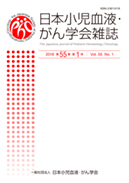Volume 57, Issue 1
Displaying 1-9 of 9 articles from this issue
- |<
- <
- 1
- >
- >|
JSPHO News
-
2020Volume 57Issue 1 Pages n57-1_1
Published: 2020
Released on J-STAGE: June 12, 2020
Download PDF (543K)
Original Article
-
2020Volume 57Issue 1 Pages 1-6
Published: 2020
Released on J-STAGE: June 27, 2020
Download PDF (2352K) -
2020Volume 57Issue 1 Pages 7-14
Published: 2020
Released on J-STAGE: June 27, 2020
Download PDF (1100K) -
2020Volume 57Issue 1 Pages 15-19
Published: 2020
Released on J-STAGE: June 27, 2020
Download PDF (993K)
Case Report
-
2020Volume 57Issue 1 Pages 20-23
Published: 2020
Released on J-STAGE: June 27, 2020
Download PDF (3190K) -
2020Volume 57Issue 1 Pages 24-27
Published: 2020
Released on J-STAGE: June 27, 2020
Download PDF (4477K) -
2020Volume 57Issue 1 Pages 28-32
Published: 2020
Released on J-STAGE: June 27, 2020
Download PDF (2008K)
Report of Committee
-
2020Volume 57Issue 1 Pages 33-37
Published: 2020
Released on J-STAGE: June 27, 2020
Download PDF (979K)
Report
-
2020Volume 57Issue 1 Pages 39-60
Published: 2020
Released on J-STAGE: June 27, 2020
Download PDF (8816K)
- |<
- <
- 1
- >
- >|
